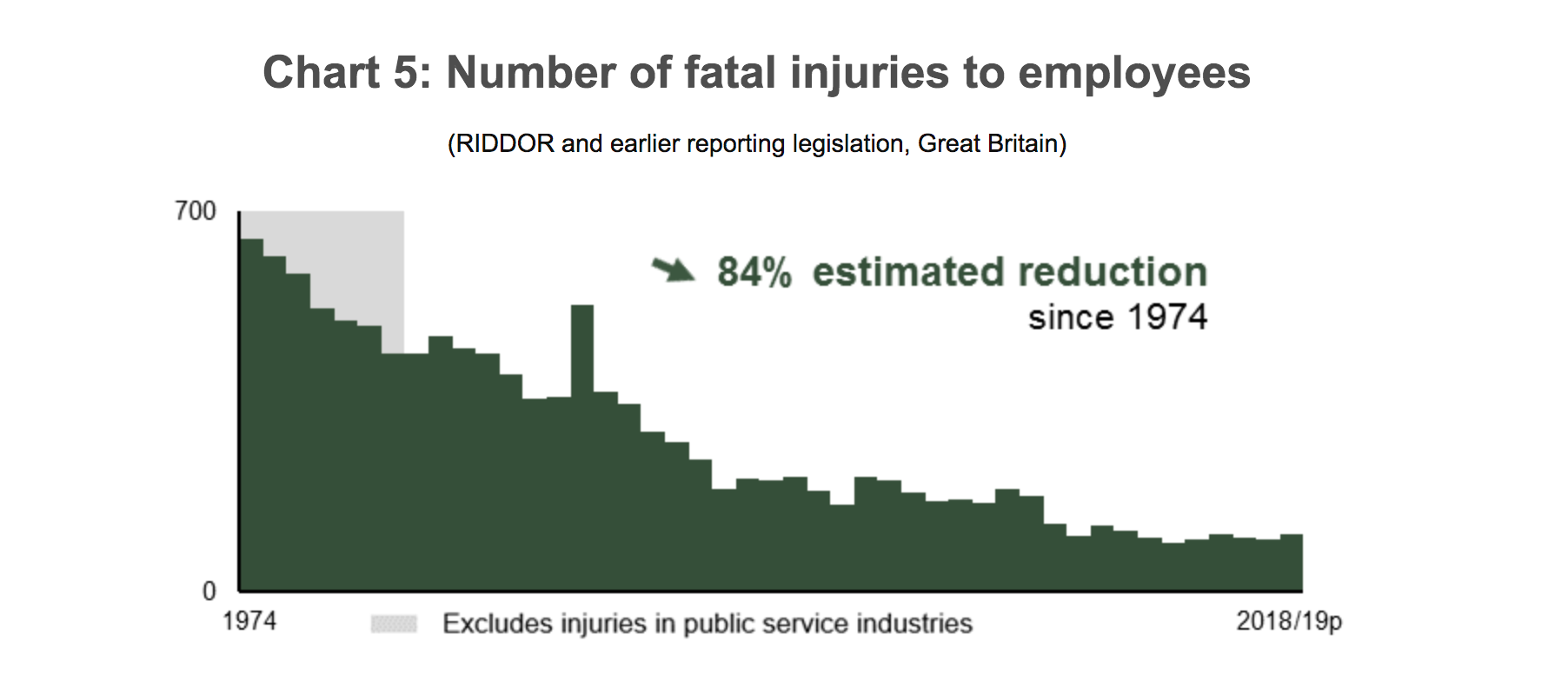All businesses need a safety inspection.
And the humble safety inspector is one of the forgotten heroes of our modern age.
I know, I know, you get it all the time. People must be buying you drinks non-stop.
In the UK, for instance, there has been an 84% decrease in the number of fatal injuries by employees at work.
In 1974, Britain saw almost 700 people die at work. Now only around 100 die each year at work. That’s about 600 fewer deaths.
Map that back to 1974 and account for a fairly consistent downward trend and we can determine that about 13,500 people didn’t die thanks to improved workplace safety. And that’s just the UK!

Those lives are on you, safety inspectors.
To show our appreciation, we’re providing a whole bunch of safety inspection checklists – from the ones you expect to the ones you don’t.
In this Process Street article, we’re gonna cover:
- What is a safety inspection?
- Why use a safety inspection checklist?
- Over 40 safety inspection checklists to use today
- How to use Process Street for safety inspections
What is a safety inspection?
A safety inspection is a systematic assessment of an area or an activity to make sure it won’t result in anyone getting hurt. It is not just a form to sign off.
If people in one industry don’t take it seriously, then that doesn’t mean you can do the same. I doubt many accountants get injured or killed at work, but 20% of workplace fatalities in America do occur to people working in construction and engineering – in the UK that figure goes up to 31%.
In fact, according to Blackline Safety, the 10 biggest causes of workplace incidents are:
- Falls
- Struck by objects
- Electrocution
- Caught in/between
- Working alone
- Cutting corners
- Lack of training
- Rushing for time
- No safety procedures
- No safety monitoring tech
Any proper set of safety inspections needs to identify and tackle all of these above risks.
It’s not just about putting up some tape and wearing helmets; one of the biggest root causes of workplace accidents comes from time-related factors.
Both rushing and tiredness can be killers. Think about when you’re driving a car. The most common cause of accidents isn’t brakes suddenly not working, it’s driver error – distracted, drunk, speeding. Things which impact human performance are the root cause of most safety concerns.
If I think about myself, the two industrial accidents which spring to mind are my granddad being squished between two freight cars and my mate Paul losing half his hand to a circular saw. In both incidents, they were rushed or rushing, with my granddad cutting corners as a result.
But don’t take my word for it.
Check out this article from the British Medical Journal, The impact of overtime and long work hours on occupational injuries and illnesses: new evidence from the United States, by A E Dembe, J B Erickson, R G Delbos, and S M Banks. (Occupational and Environmental Medicine 2005; 62:588-597).
Or, save the time and just check out this quote:
…working in jobs with overtime schedules was associated with a 61% higher injury hazard rate compared to jobs without overtime. Working at least 12 hours per day was associated with a 37% increased hazard rate and working at least 60 hours per week was associated with a 23% increased hazard rate.
And before you ask, yes, the researchers accounted for the fact that working longer hours puts you in high-risk situations longer.
The point is that we live in dangerous circumstances and need to take proper steps for ensuring safety. Those steps include how we’re being managed, resourced, and utilized.
The safety inspections shouldn’t begin onsite, they should begin up top. For every electrical inspection checklist we should see a quality management procedure.
In this article, we’re gonna give you a whole load of each.
Why use a safety inspection checklist?

If you’re reading this article then you should already know that a checklist is the most effective means to approach a safety inspection.
But if you’re not sure for some reason, then here’s why:
- A checklist is simple and hard to get wrong.
- A checklist is an extension of your memory, allowing you to check more things than you could without it.
- A checklist is a documented record of the checks you’ve done.
- A Process Street checklist is superpowered and can shoot off your results in real-time
- A checklist can have subsections for each checkpoint and information can be entered into it, provided you’re using a Process Street checklist.
There are more reasons you should use checklists, but let’s get an argument from authority for a moment. Unison, Britain’s biggest union, lays out its safety inspection guidelines:
During the inspection, an inspection report form should be completed. A checklist should be used to reduce the chance of missing a potential hazard.
The guidelines go on to give a further reason why checklists are great: you can quickly make them or adapt them. If you’re an inspector reading this article then you’ll know that the workers onsite often know more about the specifics than you do. That’s why you might sit down with them beforehand and walk through the checklist just to see if any amendments need to be made.
In short, a checklist is the ideal tool for carrying out an inspection. So here’s a whole bunch of them…
Over 40 safety inspection checklists to use today
We can split our safety inspections up into a couple of key sections.
We’re going to go for construction, electrical, quality management, IT, and commercial. But some of these could fall into multiple categories, so don’t get too wound up about it.
This is what you can expect a template to look like:
For each one of these checklists, if you like it you can just add it straight to your Process Street account. If you don’t already have an account, it’s free to sign up and Process Street is superpowered checklists – all your procedures can be stored in one place and worked through dynamically and easily. Check it out.
Safety inspections: Construction checklist templates
- Site Inspection Checklist
- Roof Inspection Report Template
- Forklift Inspection Checklist
- Facility Inspection Checklist
- Pretrip Inspection Checklist
- FHA Inspection Checklist
- Construction Proposal Template
- Construction Progress Report
- Solar Panel Installation
- Roof Installation Process
- Pool Construction Process
- Occupational Health and Safety (OHS) Audit Checklist
Safety inspections: Electrical checklist templates
- Electrical Inspection Checklist
- Electrical Inspection Checklist: Motors and Vehicles
- Electrical Inspection Checklist: Marinas, Docks, and Boatyards
- Electrical Inspection Checklist: Electric Vehicle Charging Equipment
- Electrical Inspection Checklist: Agricultural Buildings
- Electrical Inspection Checklist: Hospitals and Health Care
- Electrical Inspection Checklist: Residential Rough Inspection General
- Electrical Inspection Checklist: Air-Conditioning and Refrigerating
Safety inspections: Quality management checklist templates
- Financial Audit Checklist
- Environmental Accounting Internal Audit
- ISO 9001 Internal Audit Checklist for Quality Management Systems
- ISO 45001 Occupational Health and Safety (OHS) Audit Checklist
- ISO 27001 Information Security Management System (ISO 27K ISMS) Audit Checklist
- ISO 9001 and ISO 14001 Integrated Management System (IMS) Checklist
- ISO 9000 Structure Template
- ISO 9000 Marketing Procedures
- ISO 14001 Environmental Management Self Audit Checklist
- ISO 14001 EMS Structure Template
- ISO 14001 EMS Mini-Manual Procedures
- ISO 26000 Social Responsibility Performance Assessment Checklist
- FMEA Template: Failure Mode and Effects Analysis
Safety inspections: IT checklist templates
- Privileged Password Management
- Network Administrator Daily Tasks
- Network Security Audit Checklist
- Firewall Audit Checklist
- VPN Configuration
- Apache Server Setup
- Email Server Security
- Penetration Testing
- Network Security Management
- Client Data Backup Best Practices
- Computer Maintenance Guide
- Server Setup Process
- Virtual Private Server Setup
- IT Support Process
- Helpdesk Management
- Server Maintenance
- Server Security
- Information Security Incident Response
- SQL Server Audit Checklist
- ISO 27001 Information Security Management System (ISO27K ISMS) Audit Checklist
Safety inspections: Commercial checklist templates
- Rental Inspection Checklist
- Fire Inspection Checklist
- Restaurant Health Inspection Checklist
- Home Inspection Checklist
- Vehicle Inspection Checklist
- ISO Container Inspection Checklist
- Inventory Management Process
- Warehouse Safety Checklist
- Hotel Sustainability Audit
- Laboratory Safety Procedure Audit
- Retail Store Audit Checklist
How to use Process Street for safety inspections
Phew! Exhausting.
“It must be so difficult to manage so many checklist templates”, I hear you ask me.
The thing is, it’s not.
With Process Street it’s super easy to manage your checklists. You can set up folder systems with subfolders and subfolders and so on. And then each checklist exists as a checklist template. If you click on the overview for a template it shows you each time that template has been run as a checklist. It shows you this information like a little database so you can parse multiple runs at once, if you want to.
Beyond that, you can hook up your templates with other tools through our API, webhooks, Zapier, or Integromat to send data from a checklist in real-time. With the API or Zapier, you can even receive data from other sources to add new things into your checklist.
Process Street really is superpowered checklists.
Sign up for Process Street for free and do your inspections in the 21st Century.
Or check out some of our previous content for other checklist templates:
- 4 Checklists to Perfect Your Client Onboarding Process
- HR Templates: The Perfect Pack for Company Success
- 6 Checklists to Perfect your New Employee Onboarding Processes
- 9 Checklists to Drive Your Sales Processes
- 7 Essential Design Processes & Checklists
- 11 Checklists to Optimize Your Accounting Processes
- 8 Electrical Inspection Checklists to Keep Your Workspaces Safe
- 8 IT Security Processes to Protect and Manage Company Data
- HR Templates: The Perfect Pack For Company Success
- 12 HR Management Tips to Run an Effective Business (and Prevent Total Chaos)
- How to Make Your Own Aptitude Test with Process Street (6 Free Templates)
- Inside the Recruitment Processes of 3 Tech Giants (and How to Improve Yours!)
- Behavioral Theory of Leadership: How to Be a Better Leader
- How to Conduct an Interview: A Full Hiring Process With 11 Premade Interview Processes
- Workplace Culture: What It Is and How to Make Yours Better (With Examples)
- Employee Engagement: How to Get a Happy, Productive Team
- What is Workplace Diversity? Improving Diversity in the Workplace (8 Free Templates)
Have you used Process Street for your inspections? Let me know in the comments below! We’d love to hear about it.







 Workflows
Workflows Projects
Projects Data Sets
Data Sets Forms
Forms Pages
Pages Automations
Automations Analytics
Analytics Apps
Apps Integrations
Integrations
 Property management
Property management
 Human resources
Human resources
 Customer management
Customer management
 Information technology
Information technology




Adam Henshall
I manage the content for Process Street and dabble in other projects inc language exchange app Idyoma on the side. Living in Sevilla in the south of Spain, my current hobby is learning Spanish! @adam_h_h on Twitter. Subscribe to my email newsletter here on Substack: Trust The Process. Or come join the conversation on Reddit at r/ProcessManagement.